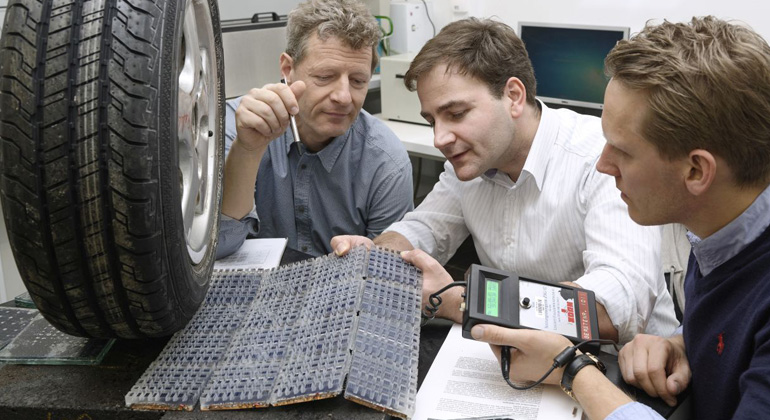Roads that Provide Energy
The RWTH Institute of Highway Engineering conducts research on energy generation using road surfaces with integrated photovoltaics.
In Germany, there are about 1.4 billion square meters of horizontal surface areas. As Lukas Renken explains, “these could be used for the generation of electricity, making it possible to provide 20 million electric cars with energy. To achieve this, photovoltaics modules are required, which must be horizontally integrated, robust, skid-proof, and optimized for energy generation.”
The researcher is part of a team led by Professor Markus Oeser from the Institute of Highway Engineering, who seek to evaluate the possibility of energy generation through road surfaces with integrated photovoltaics. The project receives funding from the Federal Ministry for Economic Affairs and Energy.
Currently, there are only photovoltaic modules for rooftops, facades and open spaces, typically facing southwards. so far, there are no modules in a horizontal design which are highly durable and provide a high energy yield. The dual use of highways for traffic and energy generation offers higher solar photovoltaic potential than the mere use of rooftops, for example.
Against this backdrop, over the next two years, the project seeks to investigate the technological and economic risks of solar modules integrated into road surfaces. For example, such modules must be able to carry heavy duty vehicles with an axle load of up to 11.5 tonnes.
Supporting the Energy Transistion
Two aspects are of particular importance given the steadily increasing energy demand: first, Germany’s transition to renewable energies makes it a priority to look for alternative, sustainable energy sources. Furthermore, increasing electric mobility results in higher electricity consumption.
“If you equip 15 percent of the traffic surfaces with solar modules, you no longer need any nuclear power station in Germany,“ explained Donald Müller-Judex from Solmove GmbH, an industrial partner in the project. “Local utilities can switch to sustainable energy and finance road maintenance costs in the long term.”
The energy expenditure for the production of the system is recuperated within three years, and the service life of the solar road components is to be 25 years – five years longer than that of conventional asphalt roads, which typically must be renewed or redeveloped after 20 years of use. As Professor Oeser puts it, “The development of a solar road makes an important contribution to the road of tomorrow.”
The solar modules have a thickness of about 5 to 6 millimeters and consist of prefabricated components. The modules, which can be freely combined and also replaced, are covered by a very stable, anti-slip type of glass. A special feature of the glass is its surface, which optimally directs the incoming light rays onto the photovoltaics layer, resulting in a high energy yield. Furthermore, as Lukas Renken explains, the photovoltaics road surface can contribute to keeping the air clean, as it also helps to reduce nitrogen oxide.
Newly Developed Demonstrator
The road surfaces are designed to be self-cleaning to maintain the system’s peak efficiency; in addition, integrated LED lamps illuminate the shoulders of the road, and the surface is acoustically optimized. Thanks to integrated induction loops, the photovoltaic surface is able to provide electric vehicles with electric power during driving. Furthermore, intermediate storage systems make it possible to store excess energy.
RWTH and Solmove GmbH have joined forces to develop a first demonstrator of a solar module. Other project partners are two Fraunhofer institutes, the Federal Highway Research Institute, Forschungszentrum Jülich, and JSJ Jodeit GmbH, a specialty glass manufacturer. Further research is to be done to take accident situations into account.
The system would be most effective for less frequently used roads – dense traffic would block the light rays from reaching the photovoltaic cells. But as Lukas Renken summarizes, “even highly frequented roads can be equipped with the new systems. We will optimize the technology over the next two years.”








